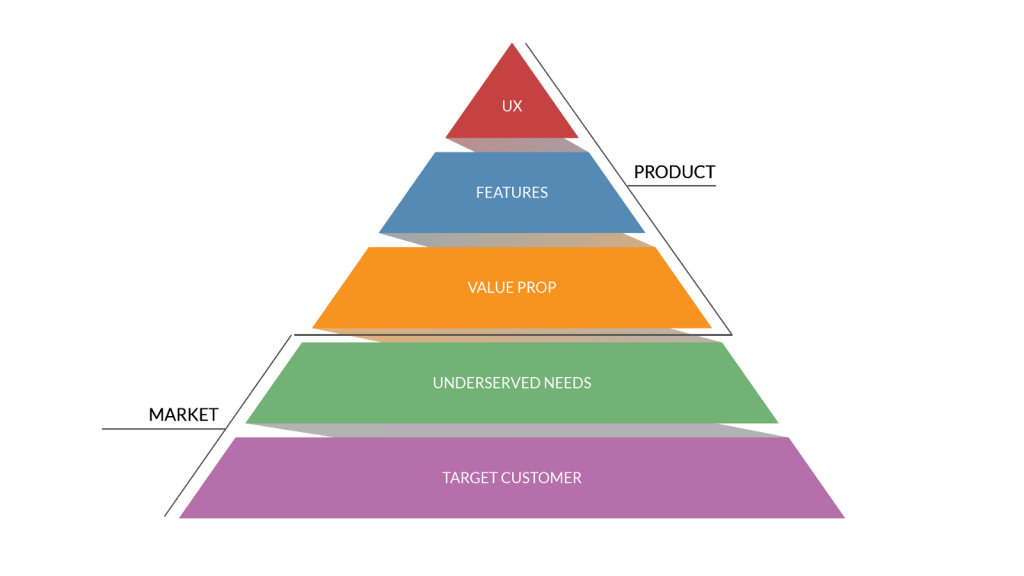For most products on the market, there is a whole gulf between what they are and what their target audience is willing to pay for. Moreover, the term “product” here means not only a product or service but also the buying process, the user experience as a whole.
Compliance with the product expectations of the target market characterizes the concept of Product-Market Fit (PMF). This term coined by Marc Andreessen in 2007.
Marc Andreessen is the co-founder of Netscape and Silicon Valley Venture Capital. He played a key role in creating the Mosaic browser. In 2009, Andreessen and his business partner, Ben Horowitz, founded the Andreessen Horowitz Venture Fund. In one of his articles, Mark Andreessen gave a definition of what Product-Market Fit is.
According to him “Product/market fit means being in a good market with a product that can satisfy that market.”

Image Source: – Gannon Hall
Product-Market Fit (PMF) is the fate of every start-up. This milestone marks the transition from finding the right product to the growth phase. To reach it is the central task of the founders, but many fail. On the other hand, the chances of success for a start-up grow considerably if the move succeeds. Accordingly, the proof of Product-Market Fit is an indispensable prerequisite for the large investment that ultimately leads the start-up to success.
What is Product-Market Fit?
Product-Market Fit means that the founders have found a product that suits their chosen market. They recognize the fit by the fact that the product is easy to sell and its customers use it permanently and profitably.

Image Source: – www.freepik.com
Product Market Fit includes more than the product alone. Rather, it refers to the entire offer of the start-up – so in addition to the product itself, for example, the revenue model, the price, the channels, and other conditions. A start-up may miss PMF if the product does bring benefits to its target audience, but it is too complicated to use or the terms and conditions are too restrictive.
Why do you need Product Market Fit?
Thinking about PMF, you create a kind of “backlog” – a guarantee that your product will be in demand. This is the foundation on which in the future you can build an effective and profitable business. One should achieve Product-Market Fit for the successful development of the company.
PMF is considered as a rather vague concept by Sean Ellis, a founder, and CEO of Growth Hackers, which was launched by Crown Business in 2017. As a VP of Marketing, he brought several companies to an IPO (LogMeIn and Uproar.com). He was the first marketer in Dropbox and Lookout. It was he who invented and popularized the term “growth hacking”.
He provided specific numbers by which you can assess the product’s compliance with market requirements. Most likely, your product needs a different positioning or its functionality should improve if it doesn’t satisfy your customers.
Common mistakes that do not allow achieving this level:
- Entry into the market without a specific plan;
- The lack of a portrait of the target audience;
- Unwillingness to include feedback.
Example: the target audience likes your product, but the lack of a return policy stops users. Your direct competitor offers clear rules for refunds if the product doesn’t fit. In this case, none of your advertising campaigns will help you to increase your sales, no matter how much traffic it attracts.
To make people want to buy, you will have to reach or at maximum get closer to the state of Product Market Fit. You need to start listening to feedback. You may even have to give up your own vision. But in the end, you can give your customers what they want.
How to Achieve Product Market Fit?
Steve Blank, author of the legendary book “Start-up”. The founder’s handbook talks about the Customer Development approach. This is the concept of sales, which is based on a deep understanding of the client, determining his needs and ulterior motives for the subsequent development of a successful product.

Image Source: –
The idea is that if the product meets all the expectations and preferences of the audience, users will be happy to buy it. In his book, Steve Blank writes about the need to validate business ideas i.e. the need to test your product for compliance with market expectations.
The validation process includes the following steps:
- Describe your customer in as much detail as possible.
- Specify what problems customers have?
- What solution can you offer?
- What risks of validation do you see?
Based on the answers, formulate a proposal that you send to your customers.
Validation of business ideas is required not only at the start-up stage. If you are an owner of an already developed business, using this technique in conjunction with feedback from users will help improve your product or expand your business.
Three circumstantial proofs for Product-Market Fit
There are three indicators that founders can deduce that they are approaching the PMF; these are called Customer Statements, Commitment, and Retention.
- Customer Statements

Image Source: –
A common test for PMF proximity is asking customers, “How would you feel if you were not able to use our product?” If at least 40% of customers say they are very disappointed, then you can Close Product-Market Fit. Sean Ellis has suggested this test for better knowing the customers.
A similar possibility is to determine the Net Promoter Score (NPS). The NPS measures the proportion of customers who declare that they would recommend the product to others. A share of 20% or higher is considered good and an indicator of PMF.
The advantage of these customer statements is that they can be easily and quickly identified. The disadvantages are that in reality, people often do not behave as they say and it is possible to misinterpret the survey results.
- Engagement
Commitment is the intensity or frequency of use of a product. The more or the more frequently a product is used, the greater its benefit for the target group. That’s why it’s very important for start-ups to measure the engagement of their users.

Image Source: – Alejandro Ramirez
The advantage of this method is that it captures the actual behavior of users. The Disadvantage is that single results can be difficult to interpret. But if a positive trend is detected, the founders can conclude that they are closer to the PMF.
- Retention
Retention measures customer loyalty. The retention is 100% if every new customer returns and buys the product again, or stays with another subscription model for another month. The longer the customers stay, the better the product meets their needs.
Advantages of this method are that it is objective and has high reliability. On the other hand, the first results wait a very long time, because a subscription, for example, is renewed only on a monthly basis.
Finally
Achieving Product-Market fit means that you have found a market segment where customers choose your product to solve their problems. There are several ways to evaluate how far you are from this goal.
It is important to understand that PMF is only an intermediate point on the way to building a business around a product. After reaching PMF, you have to look for distribution channels to reach the market segment where the product generates value. And then work on mixing the economy within the found channels.
So, does your product meet user expectations? If the answer is no, then this is the real reason people don’t buy from you.


